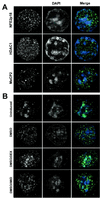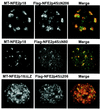Nuclear relocation of a transactivator subunit precedes target gene activation
- PMID: 11593025
- PMCID: PMC59778
- DOI: 10.1073/pnas.211444898
Nuclear relocation of a transactivator subunit precedes target gene activation
Abstract
Murine erythroleukemia (MEL) cells are a model system to study reorganization of the eukaryotic nucleus during terminal differentiation. Upon chemical induction, MEL cells undergo erythroid differentiation, leading to activation of globin gene expression. Both processes strongly depend on the transcriptional activator NF-E2. Before induction of differentiation, both subunits of the NF-E2 heterodimer are present, but little DNA-binding activity is detectable. Using immunofluorescence microscopy, we show that the two NF-E2 subunits occupy distinct nuclear compartments in uninduced MEL cells; the smaller subunit NF-E2p18 is found primarily in the centromeric heterochromatin compartment, whereas the larger subunit NF-E2p45 occupies the euchromatin compartment. Concomitant with the commitment period of differentiation that precedes globin gene activation, NF-E2p18, along with other transcriptional repressors, relocates to the euchromatin compartment. Thus, relocation of NF-E2 p18 may be a rate-limiting step in formation of an active NF-E2 complex. To understand the mechanisms of NF-E2 localization, we show that centromeric targeting of NF-E2p18 requires dimerization, but not with an erythroid-specific partner, and that the transactivation domain of NF-E2p45 may be necessary and sufficient to prevent its localization in centromeric heterochromatin. Finally, using fluorescence in situ hybridization, we show that, upon differentiation, the beta-globin gene loci relocate away from heterochromatin compartments to euchromatin. This relocation correlates with both transcriptional activation of the globin locus and relocation of NF-E2p18 away from heterochromatin, suggesting that these processes are linked.
Figures






Similar articles
-
Activation of beta-major globin gene transcription is associated with recruitment of NF-E2 to the beta-globin LCR and gene promoter.Proc Natl Acad Sci U S A. 2001 Aug 28;98(18):10226-31. doi: 10.1073/pnas.181344198. Epub 2001 Aug 21. Proc Natl Acad Sci U S A. 2001. PMID: 11517325 Free PMC article.
-
NF-E2p18/mafK is required in DMSO-induced differentiation of Friend erythroleukemia cells by enhancing NF-E2 activity.Leukemia. 1997 Feb;11(2):273-80. doi: 10.1038/sj.leu.2400552. Leukemia. 1997. PMID: 9009092
-
Nitric oxide-releasing agents and cGMP analogues inhibit murine erythroleukemia cell differentiation and suppress erythroid-specific gene expression: correlation with decreased DNA binding of NF-E2 and altered c-myb mRNA expression.Cell Growth Differ. 1995 Dec;6(12):1559-66. Cell Growth Differ. 1995. PMID: 9019161
-
ChIPs of the beta-globin locus: unraveling gene regulation within an active domain.Curr Opin Genet Dev. 2002 Apr;12(2):170-7. doi: 10.1016/s0959-437x(02)00283-6. Curr Opin Genet Dev. 2002. PMID: 11893490 Review.
-
The role of transcription factor NF-E2 in megakaryocyte maturation and platelet production.Stem Cells. 1996;14 Suppl 1:112-5. doi: 10.1002/stem.5530140714. Stem Cells. 1996. PMID: 11012210 Review.
Cited by
-
Centromere architecture breakdown induced by the viral E3 ubiquitin ligase ICP0 protein of herpes simplex virus type 1.PLoS One. 2012;7(9):e44227. doi: 10.1371/journal.pone.0044227. Epub 2012 Sep 20. PLoS One. 2012. PMID: 23028505 Free PMC article.
-
Olfactory receptor genes expressed in distinct lineages are sequestered in different nuclear compartments.Proc Natl Acad Sci U S A. 2015 May 5;112(18):E2403-9. doi: 10.1073/pnas.1506058112. Epub 2015 Apr 20. Proc Natl Acad Sci U S A. 2015. PMID: 25897022 Free PMC article.
-
Targeted deficiency of the transcriptional activator Hnf1alpha alters subnuclear positioning of its genomic targets.PLoS Genet. 2008 May 23;4(5):e1000079. doi: 10.1371/journal.pgen.1000079. PLoS Genet. 2008. PMID: 18497863 Free PMC article.
-
The principles of nuclear structure.Chromosome Res. 2003;11(5):387-401. doi: 10.1023/a:1024954123092. Chromosome Res. 2003. PMID: 12971716 Review.
-
Three-dimensional positioning of genes in mouse cell nuclei.Chromosoma. 2008 Dec;117(6):535-51. doi: 10.1007/s00412-008-0168-2. Epub 2008 Jul 3. Chromosoma. 2008. PMID: 18597102
References
Publication types
MeSH terms
Substances
Grants and funding
LinkOut - more resources
Full Text Sources

